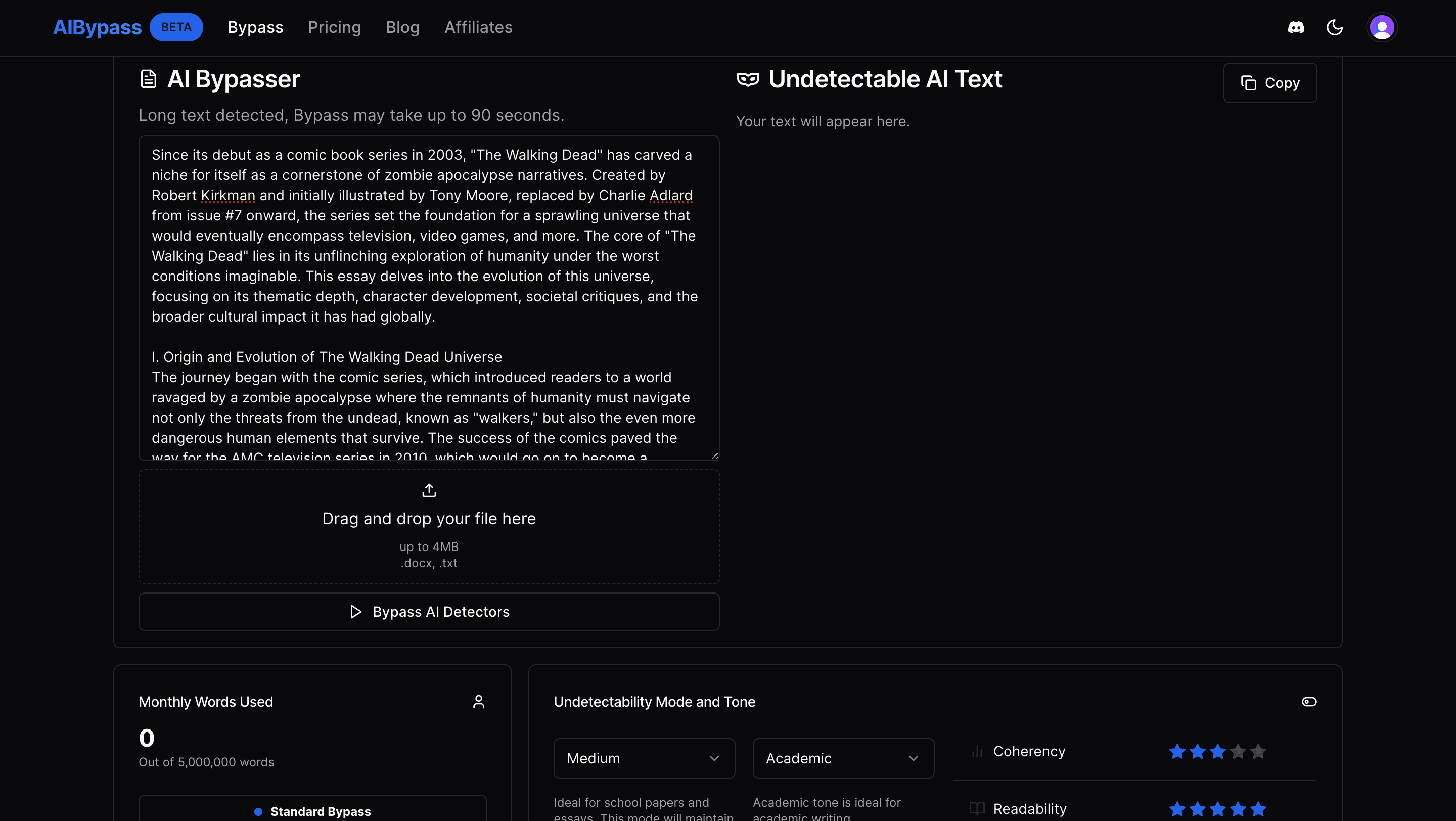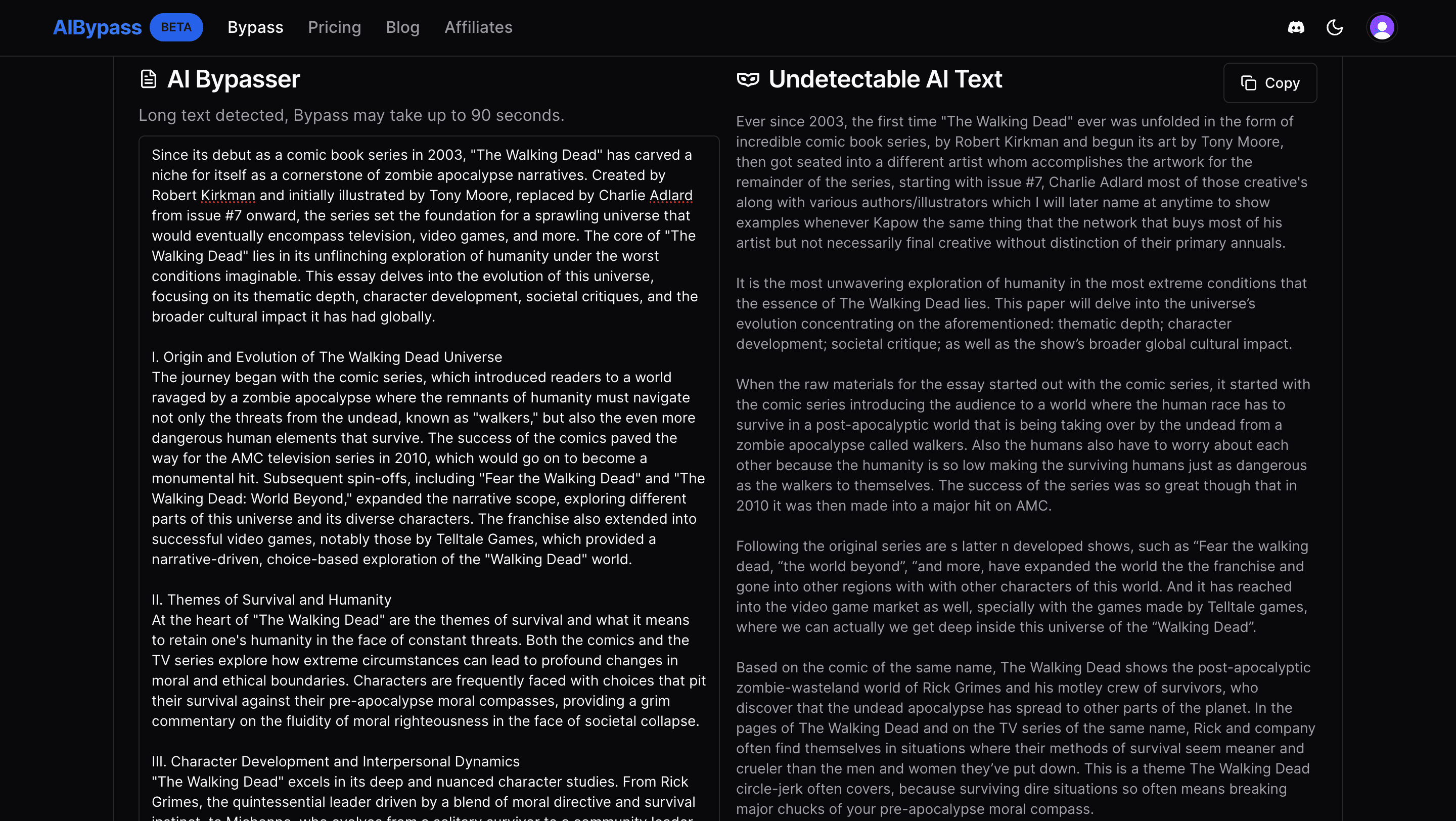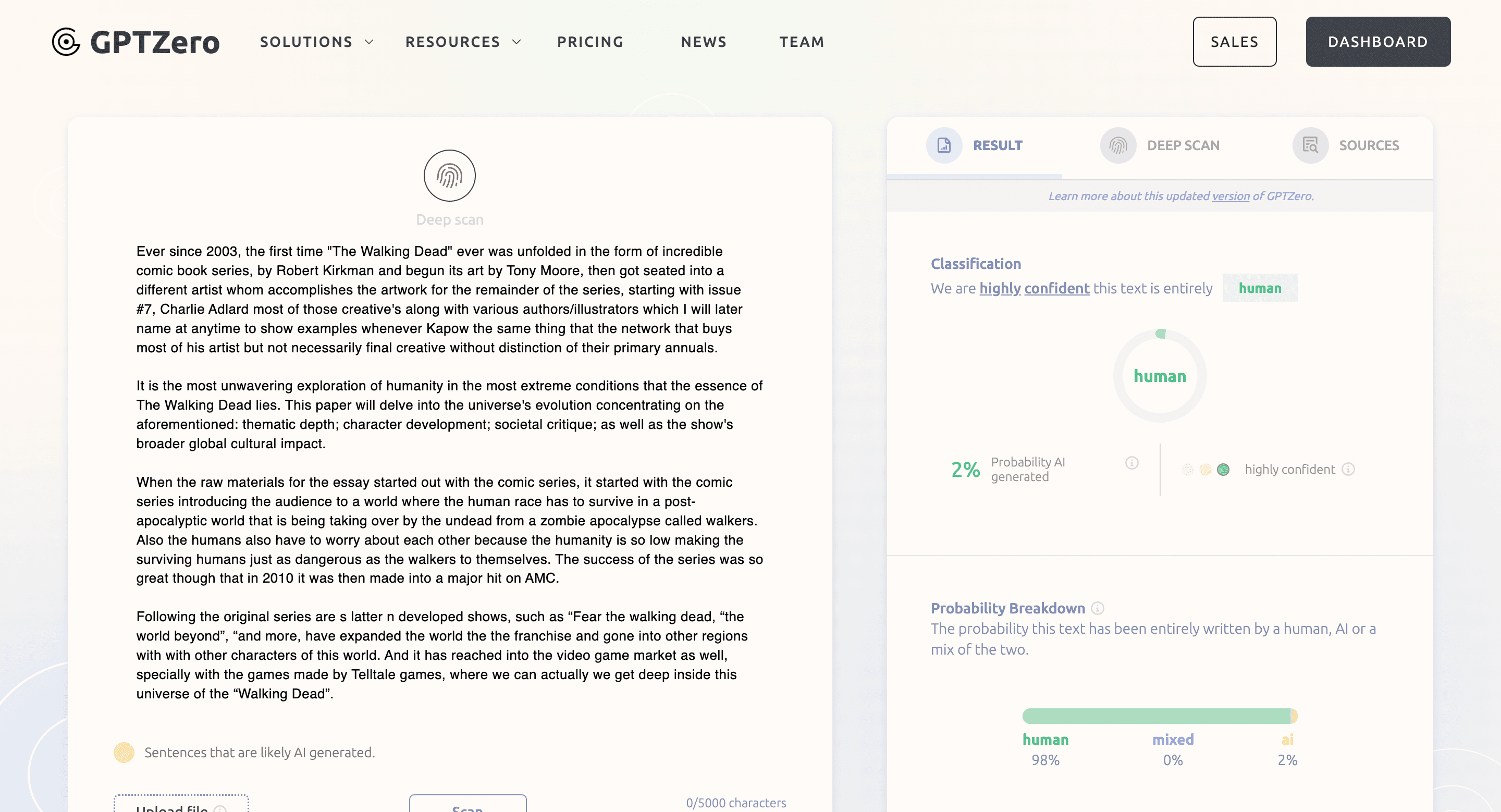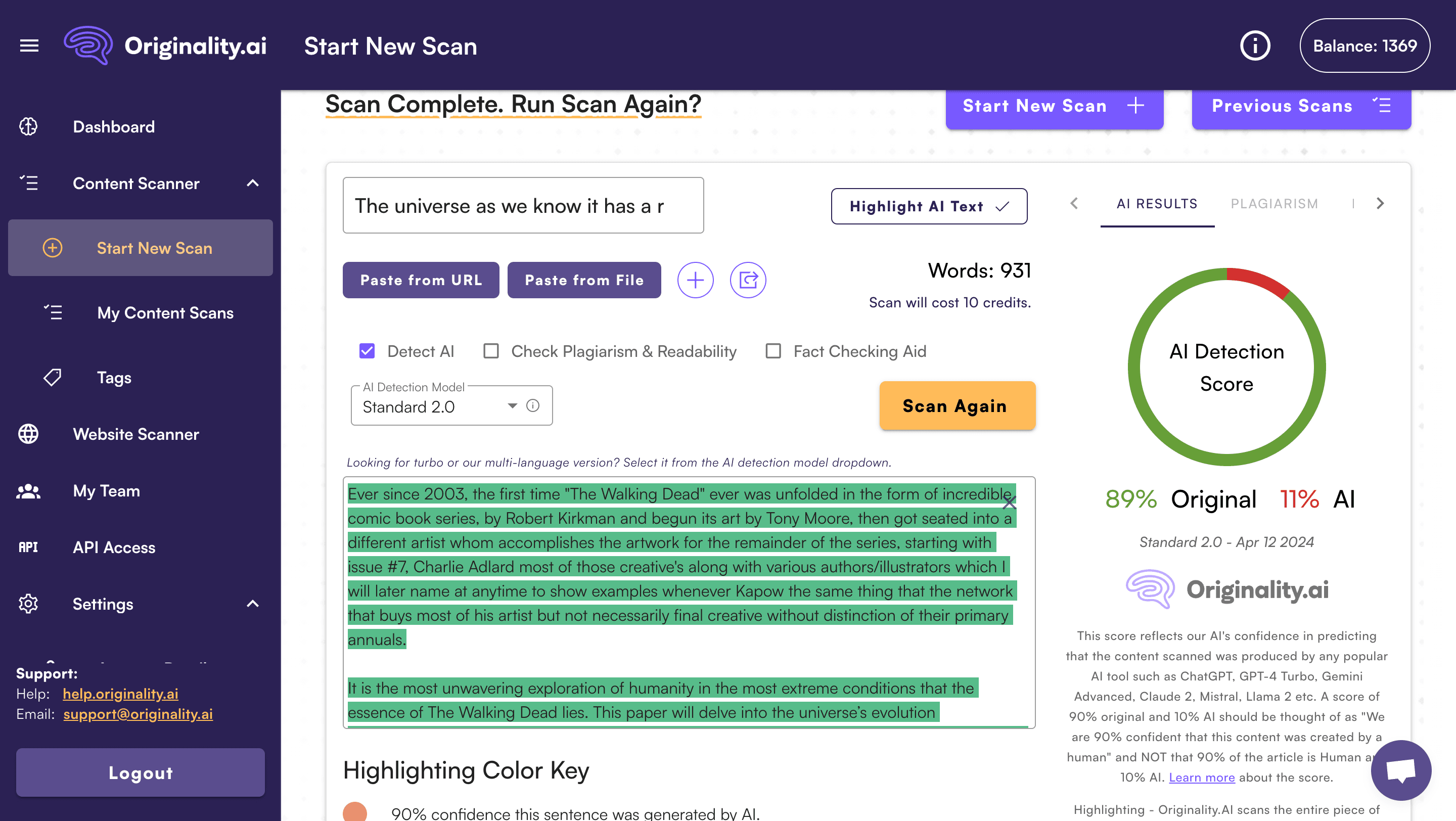Here's a how-to guide on how to bypass artificial intelligence detectors:How to Bypass Artificial Intelligence Detectors Using AI Bypass
By using AI Bypass, you can bypass major artificial intelligence detectors such as GPTZero, Originality, and TurnItIn. Let's make a prompt on ChatGPT then use AI Bypass to make the newly written undetectable ai text against AI detectors. Finally, we will check to see if it can truly bypass them.  Let's make a blog post about the walking dead universe. Here's what it looks like.
Let's make a blog post about the walking dead universe. Here's what it looks like. Let's put the prompt into AI Bypass' website and select medium undetectability mode and academic tone.
Let's put the prompt into AI Bypass' website and select medium undetectability mode and academic tone. Finally, let's click "Bypass AI Detectors." It's that simple. We'll copy the newly written content and place them against GPTZero and Originality to see how well it does.
Finally, let's click "Bypass AI Detectors." It's that simple. We'll copy the newly written content and place them against GPTZero and Originality to see how well it does. Human written. That's all we needed to hear. 2% AI written content is an amazing result that shows just how powerful AI Bypass is. We can safely say that AI Bypass can surpass GPTZero. Let's see how well AI Bypass is against Originality next.
Human written. That's all we needed to hear. 2% AI written content is an amazing result that shows just how powerful AI Bypass is. We can safely say that AI Bypass can surpass GPTZero. Let's see how well AI Bypass is against Originality next. Not bad at all. Mostly human written. AI Bypass can bypass Originality as well. AI Bypass has different undetectability mode and tone feature that gives you the coherency, readability, and undetectability for each prompt. You can adjust the settings to give different answer each time if you are unsatisfied with your results.
Not bad at all. Mostly human written. AI Bypass can bypass Originality as well. AI Bypass has different undetectability mode and tone feature that gives you the coherency, readability, and undetectability for each prompt. You can adjust the settings to give different answer each time if you are unsatisfied with your results.
What Are Artificial Intelligence Detectors?
Artificial Intelligence Detectors are sophisticated tools that help identify content generated by AI or check for plagiarism and originality in submissions. Notable examples include GPTZero, Originality.ai, and TurnItIn. These detectors are vital in maintaining the authenticity and integrity of academic work, journalistic content, and other professional writings. By analyzing various metrics and patterns, they can distinguish between human and machine-generated content, ensuring compliance with ethical standards.How Do Artificial Intelligence Detectors Work?
Artificial Intelligence Detectors are tools designed to differentiate between content created by humans and machines. These detectors are crucial in fields like academia, where they ensure the integrity of scholarly work, and in media, where they help maintain trust and authenticity in published content. Here's a closer look at the typical functionalities and methodologies employed by these detectors:1. Linguistic Analysis
Most AI detectors start with a deep linguistic analysis of the text. This involves examining:- Syntax and Grammar: AI-generated text often has unique syntactic patterns or may use grammar differently than a human typically would.
- Semantic Consistency: Detectors analyze whether the text maintains consistent meaning and context throughout, as AI can sometimes generate content that is contextually disjointed or logically inconsistent.
2. Stylistic Patterns
AI detectors often look for stylistic cues that are commonly found in machine-generated text:- Repetition: AI tends to repeat certain phrases or words more than humans, which can be a red flag for detectors.
- Sentence Structure: The complexity or variability of sentence structures can indicate AI authorship, as AI may use overly complex or overly simple sentence structures consistently.
- Unusual Coherency
3. Machine Learning Techniques
Many AI detectors use machine learning algorithms to improve their detection capabilities over time:- Training on Datasets: Detectors are trained on large datasets of human-written and AI-generated text to learn distinguishing features.
- Adaptive Learning: Some AI detectors continuously adapt based on new inputs, improving their ability to identify AI-generated text with greater accuracy.
4. Benchmarking Against Known Standards
Some detectors benchmark texts against a database of known human-written content to determine the likelihood of AI authorship:- Cross-Referencing: By comparing the submitted text to a database of verified human-created content, detectors can more reliably flag content that deviates significantly from human norms.
5. Integration of Plagiarism Detection
For academic AI detectors like TurnItIn, the technology also incorporates plagiarism detection to ensure that the text is not only original but also not copied from existing human-authored sources.By combining these methods, AI detectors can effectively identify content that likely originates from AI sources, helping uphold standards of authenticity and integrity across various domains. As AI technology evolves, so too do the detectors, continually adapting to new challenges in the AI landscape.What is AI Bypass?
AI Bypass, utilizing StealthGPT technology, specializes in adapting AI-generated text to evade detection by prominent AI detectors such as Turnitin, GPTZero, and Originality. The service strategically modifies text by rephrasing and rewriting to mimic human writing styles, significantly lowering the probability of detection. It features a swift response capability, handling substantial text volumes, and compatibility with various file types, ensuring broad usability. The service markets itself particularly for its effectiveness against Turnitin, highlighting a high success rate in bypassing detection.How to Bypass Artificial Intelligence Detectors Using AI Bypass
By using AI Bypass, you can bypass major artificial intelligence detectors such as GPTZero, Originality, and TurnItIn. Let's make a prompt on ChatGPT then use AI Bypass to make the newly written undetectable ai text against AI detectors. Finally, we will check to see if it can truly bypass them. 





